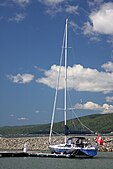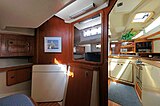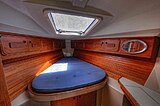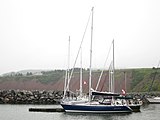C&C 37/40
 | |
 | |
| Development | |
|---|---|
| Designer | Cuthbertson & Cassian (C&C Designs) |
| Location | Canada |
| Year | 1988 |
| No. built | 105 (all models) |
| Brand | C&C |
| Builder(s) | C&C Yachts |
| Role | Offshore Cruiser/Racer |
| Name | C&C 37/40 |
| Boat | |
| Displacement | (37/40+) 16,700 lb (7,575 kg), (37/40XL) 15,900 lb (7,212 kg), (37/40R) 14,900 lb (6,759 kg) |
| Draft | from 4.92 ft (1.50 m) to 7.25 ft (2.21 m) or 8.16 ft (2.49 m) depending on keel fitted. 1.8 ft (0.55 m) |
| Air draft | 60 ft (18 m) or 62 ft (19 m) for tall mast. |
| Hull | |
| Type | Monohull |
| Construction | Fibre-reinforced plastic using DuPont hybrid material that combines Kevlar with fiberglass. |
| LOA | 39.5 ft (12.0 m) |
| LWL | 31.83 ft (9.70 m) |
| Beam | 12.58 ft (3.83 m) |
| Engine type | Universal Model 35 or Yanmar 30 hp (22 kW) diesel engine |
| Hull appendages | |
| Keel/board type | fin keel (wing or keel/centreboard are options) |
| Ballast | 7,000 lb (3,175 kg) lead |
| Rudder(s) | internally-mounted spade-type rudder |
| Rig | |
| General | Bermuda rig, keel stepped mast |
| I foretriangle height | (37/40+) 52.00 ft (15.85 m), (37/40XL) 53.50 ft (16.31 m), (37/40R) 54.00 ft (16.46 m) |
| J foretriangle base | (37/40+) 16.00 ft (4.88 m), (37/40XL) 16.00 ft (4.88 m), (37/40R) 15.58 ft (4.75 m) |
| P mainsail luff | (37/40+) 45.67 ft (13.92 m), (37/40XL) 47.25 ft (14.40 m), (37/40R) 48.20 ft (14.69 m) |
| E mainsail foot | (37/40+) 15.50 ft (4.72 m), (37/40XL) 15.50 ft (4.72 m), (37/40R) 15.58 ft (4.75 m) |
| Mast length | 59.83 ft (18.24 m) |
| Sails | |
| Sailplan | Masthead sloop |
| Mainsail area | (+) 353.94 sq ft (32.882 m2), (XL) 366.19 sq ft (34.020 m2), (R) 377.19 sq ft (35.042 m2) |
| Jib/genoa area | (+) 416.00 sq ft (38.648 m2), (XL) 428.00 sq ft (39.763 m2), (R) 420.66 sq ft (39.081 m2) |
| Total sail area | (+) 769.94 sq ft (71.530 m2), (XL) 794.19 sq ft (73.783 m2), (R) 420.66 sq ft (39.081 m2) |
| Racing | |
| PHRF | 75 (average) |
← C&C 37
C&C 121 →
| |
The C&C 37/40 is a Canadian sailboat, that was designed by Robert Ball[1] of Cuthbertson & Cassian (C&C Designs) and first built in 1988. The design is out of production.[2][3][4] One Hundred and five of the 37/40 type were built before the Canadian plant closed in 1994.[2]
There are three basic models, the semi-custom C&C 37/40 R "racing" model with a deep draft 8.16 ft (2.49 m) keel and a lighter, more race oriented interior; the 37/40+ with a full cruising interior and several keel options including wing keel, keel / centreboard, and deep keel; and the 37/40 XL which is a combination of the 37/40+ cruising interior with the lighter hull, taller mast, and deeper keel of the racing "R" version. At this point in C&C's history these boats were essentially semi-custom so could be ordered and built with any of a number of different rig and keel combinations, hull layups, and transom configurations (open or closed).
Production
First introduced in 1988, this second version of the C&C 37 (by Rob Ball) is a completely different design from the earlier C&C 37 dating from 1981. Initially intended as an updated replacement for the earlier 37, the 37/40 gradually stretched out during the design process until its final overall length was almost 40 ft (12 m).[5] In an interview Rob Ball said they drew a nice 37-foot interior, then just stretched the ends to give the boat more grace and style. All of the construction drawing from the design phase refer to this boat and the "new 37+" and it was first offered as the C&C 37R and C&C 37+[1] but soon was marketed as the C&C 37/40R and C&C 37/40+ due to its actual LOA of 39.5 ft (12.0 m). On the design Rob Ball said:
I really love that design, and feel it really was/is the culmination of all the past experience, and designs that I did . . . .
The fun part was that the goal of the basic design was ‘A Fast Boat’ without any distortions for handicap rules . . The rule being used mostly was PHRF and keeping the name at 37 when the boat was actually longer than that was a tongue-in-cheek effort to fool the handicappers when it was introduced . . . After the boat was sailing and presumably sailing better than a 37 footer, they would change the rating – but by then we would have at least created ‘notice’ in the marketplace – HA . . . . . In truth I did have a 37.49 foot design ready, but pleaded with marketing to lengthen it. Indeed it was the longest waterline 37 footer, the most interior 37 footer, maybe the fastest 37 footer . . . . BUT it was also the most expensive 37 footer . . . . The marketing guys pushed for the name change(s) . . .
Everyone that I have run into – love the boat . . . .
The C&C 37/40 was later rebranded the C&C 40 (from 1993 on) with the length code in the Hull Identification Number (HIN) changing from 37 to 40 for the boats built in 1993 and later, though there were no significant changes in the design at this time.
Design
The C&C 37/40 is a small recreational keelboat of moderate displacement, intended as a cruiser/racer or oceangoing racer (depending on model).
- Hull and Deck
- The construction of the C&C 37/40 was ahead of it's time. Utilizing aircraft grade pre-impregnated balsa core material and Kevlar / fibreglass fabric, the hull and deck are laid up using vinylester resin for strength, blister resistance and light weight. The C&C 37 Plus series are built up with isophthalic (Hydrex) gelcoat, C&C's exclusive Kevlar hybrid, E-Glass, pre-impregnated end-grain Baltek AL-600 balsa (1 in (25 mm) balsa core in hull and .75 in (19 mm) in deck) and Hydrex resin. Hydrex, a modified isophthalic, has higher hydrolytic stability, toughness and is more crack resistant than conventional resins. The layups of the R and XL series use Kevlar hybrid exclusively with Hydrex resin on both sides of a core of Balteck AL-600 aircraft grade balsa. All materials are Lloyd's approved. These exclusive C&C laminate schedules result in hulls and decks which despite significant weight reduction are stronger than the conventional glass laminates of the time. They are not only much lighter, but stiffer and more rigid. Additional unidirectional glass is used in highly stressed areas with aluminum and coremat hardware backing. The boot stripe is molded in the hull for fairness to the hull surface and to reduce maintenance requirements.[6]
- All of the interior liners are overlaid and bonded to the hull and deck and the hull to deck joint is bonded with adhesive and then mechanically fastened with stainless steel bolts through the signature C&C slotted aluminum toerail. The fixed elliptical fin keel has an eight percent foil at the root with reduced chord and an extended trailing edge-hull fillet for interference drag reduction, and an eleven percent foil at the tip to help lower the centre of gravity (VCG). A keel / centreboard combination is an option. The D/L ratio ranges from 206 to 231, depending on model. The opening transom is simple to operate and transforms to a walk through transom / swim platform including an integral folding ladder providing easy access to the water. The R version had an open transom.
- Rudder & Steering
- The 5.5 ft (1.7 m) rudder is an internally-mounted spade-type with a "spitfire wing" planform. The rudder is constructed of two molded composite shells which are bonded together and injected with two-part foam for added strength. The rudder post is all stainless steel with a flat stainless steel plate reinforcing weldment positioned within the rudder.
- The rudder may be removed by loosening the bolt, rollers and quadrant. The rudder must be supported from below during this procedure, then lowered carefully. The rudder post passes through the hull with a water-tight, close tolerance fit between the shaft and the nylon bearing.
- Wheel steering is standard. The pedestal system is cable-linked with the radial driver being connected to the rudder post by a keyway and lock nuts. Access to the system is achieved via the removable fiberglass cover located in the cockpit sole.[6]
- Ballast
- The keel is of lead alloyed with antimony for added strength and cast to exacting tolerances. In addition to providing the yacht's stability, the foil shape of the keel produces hydrodynamic lift while sailing to weather, enhancing upwind performance.
- The keel is fastened to the hull by means of eight stainless steel bolts of up to 1.5 in (38 mm) diameter, which are cast into the lead. These bolts project through the bottom of the boat and are bedded with sealing material to prevent water leaks. The bolts are secured by 2.25 in (57 mm) stainless steel nuts and washers which are visible in the bilge.[6]
- Mast & Rigging

- The spars are designed by C&C and fabricated by Offshore Spars. The standard boat has a keel stepped non-tapered double spreader masthead sloop rig, with rod rigging and a hydraulic backstay adjuster.[7] the R and XL variants have a tapered triple-spreader mast with all rod rigging, plus runners, checkstays, and an adjustable babystay for mast bend control.[5] The masthead, gooseneck and boom end are custom machined aluminum, welded to the one piece extrusion. The aerodynamic spreaders are secured to the mast via machined, continuous aluminum spreader bars. They precisely fit the spreader bases and traverse the mast and along with separate support bars carry the compression loads exerted by the shrouds.
- The aft cockpit layout has all halyards and controls led through rope clutches to a pair of two-speed winches at the aft corners of the cabin top. The primary and secondary winches are positioned at the margins of the wide cockpit. Mainsheet control is through a mainsheet traveller with roller bearing car and crosshaul tackle recessed into the bridgedeck. Two inboard genoa tracks with low lead genoa cars rolling on ball-bearing travelers to permit adjustment while under-way and there are additional inboard leads for the light Genoa inset at the aft corners of the cabin.[5]
Variants
- C&C 37/40 R
This model, produced from 1988 to 1990, is laid out for racing and was designed to be competitive under the then current IMS handicapping rule.[8] The 37R hull is built with fibre-reinforced plastic using DuPont hybrid material that combines Kevlar with fiberglass. This combined with C&C's usual balsa core results in a very high strength or stiffness to weight ratio. Unidirectional glass is used for additional local stiffening.[1] Its interior, rather than being based upon moulded pans and liners of the cruiser/racer 37/40+, is organized around a series of plywood longitudinals and bulkheads. These plywood members are rigidly glassed to the hull and contribute considerably to the strength and stiffness of the hull. The massive aluminum chainplates are bolted to sturdy plywood webs which form the back of the settees.[5]
The R variant has a draft of 8.16 ft (2.49 m) with the standard elliptical keel and a tall, tapered triple-spreader mast with all rod rigging, plus runners, checkstays, and an adjustable babystay for mast bend control.[5] The R has a PHRF racing average handicap of 66 with a high of 72 and low of 63. It has a theoretical hull speed of 7.36 kn (13.63 km/h). The boat is fitted with a Universal Model 35 diesel engine of 30 hp (22 kW). The fuel tank holds 20 U.S. gallons (76 L; 17 imp gal) and the fresh water tank has a capacity of 30 U.S. gallons (110 L; 25 imp gal).[9][10] It displaces 14,900 lb (6,759 kg) and carries 7,200 lb (3,266 kg) of lead ballast, though this varies from boat to boat with a number of 37/40 R's having lighter or custom keels.[7]
The 37R was quite successful on the race course.[11] On first release the boat proved so fast that orders for the racing model totally overwhelmed the orders for the more subdued cruise-race model 37/40+.[1] The R version can be distinguished from their sister 37/40+ and XL by an "R" in the length code in the HIN, the exception being the first 37R built, Fast Track (now Holo Nui), hull number 2 in the series, and the second 37R, Andromeda (now Seacan), hull 5 in the series, which have no "R" in their HIN. Somewhere in the first 10 hulls, C&C raised the freeboard by about 1 in (25 mm) to get more headroom under the IMS rule.[2] Over the production run 25 of the 37R were built.
- C&C 37/40+

This model, produced from 1988 to 1994, was based on the 37/40 R hull, but fitted out with a full cruising interior.
- Accomodations
- Starting in the forward stateroom, there is a 6.4 ft (2.0 m) long centreline V-berth, with teak staving on the hullsides and louvered teak lockers along either side over the berth. There is a hanging locker to port and a second hanging locker to starboard along with a vanity with sink and mirror. The starboard portion of the bulkhead opens to the salon if desired to add visual space to an already large living area. Ventilation and lighting is provided by a large overhead hatch and two overhead lights.

- Moving aft into the saloon, there is a straight settee to port, the aft end of which provides seating for the aft facing nav station. A removable seat back slips in to give the navigator a comfortable back rest. The nav station has drawer storage beneath it and a large chart table with ample room to spread out on it. The electronics and electrical panels are arrayed in a convenient console style.
- To starboard is a curved settee that converts to a double berth when required. An inlaid teak table with two drop leaves surrounds the keel stepped mast. There are teak shelves and louvered locker storage behind both settees.
- The entire galley/saloon/nav area is illuminated and ventilated by a large skylight, five fixed lights, four hatches, overhead lighting, four reading lights and nighttime courtesy lighting along the floor.
- Aft of the nav station on the port side at the base of the companionway is the head. A louvered teak bi-fold door provides access to the space. Built as a complete molded head unit with full headroom and good ventilation, it includes a vanity sink, marine head, an abundance of mirrored storage cabinets, and a large separate stall shower with a Plexiglas door and dividing partition. Hot and cold pressurized water system and electric shower sump pump complete the systems.

- Aft of the settee on starboard and is the galley. L-shaped, it features a large top opening ice box / refrigerator, 7.6 cu ft (0.22 m3) capacity, three burner propane stove with oven, hot and cold pressure water, and a deep double centreline sink. Outboard along the hull are numerous storage spaces and lockers for storage, including organizers for silverware and dishes. Pot storage is located below the stove and there is additional storage above and below the galley sink area.
- Continuing aft past the galley is the entrance to the spacious aft stateroom. Featuring an island centerline queen berth a spacious 6.5 ft (2.0 m) x 5 ft (1.5 m) with a padded headboard. There is shelf, locker and hanging storage on both sides of the cabin. Numerous lights, mirrors, and four opening ports for ventilation and light.
The 37/40+ displaces 16,700 lb (7,575 kg), carries 7,000 lb (3,175 kg) of ballast with the wing keel (draft of 5.92 ft (1.80 m)) or elliptical keel with small "beaver tail" bulb (draft of 7.25 ft (2.21 m)). It is also available with a shallow draft keel / centreboard combination with 7,800 lb (3,538 kg) of ballast. The boat has a PHRF racing average handicap of 75 with a high of 75 and low of 75. It has a theoretical hull speed of 7.36 kn (13.63 km/h). The boat is fitted with a Universal diesel engine of 30 hp (22 kW), although a Yanmar diesel engine was a later option.[2][3] The engine has full access on three sides. The fuel tank holds 44 U.S. gallons (170 L; 37 imp gal) and the three fresh water tanks have a combined capacity of 79 U.S. gallons (300 L; 66 imp gal).[2] Over the production run 65 were built.
- C&C 37/40 XL
This model, produced from 1989 to 1994, is a combination of the 37/40 R's lighter hull, deeper keel and taller triple-spreader rig, combined with the full cruising interior of the 37/40+ . It displaces 15,700 lb (7,121 kg) and carries 7,200 lb (3,266 kg) of ballast. The boat has a draft of 8.16 ft (2.49 m) with the standard fixed fin keel and 4.92 ft (1.50 m) with the optional centreboard/keel (centreboard up). The boat has a PHRF racing average handicap of 105 with a high of 109 and low of 78.[12][13] Over the production run 15 of this variant were built.
See also
Similar sailboats
Gallery
-
A C&C 37/40 XL lying at dock at Ben Eoin Yacht Club on Cape Breton Island.
-
A view of the interior of a C&C 37/40 looking forward through saloon.
-
A view of the Galley and Companionway of a C&C 37/40 looking aft to starboard.
-
A view of the Aft Stateroom of a C&C 37/40 looking forward through the galley.
-
A view of the Aft Stateroom and Queen Berth of a C&C 37/40 looking aft.
-
A view of the Forward Guest Stateroom of a C&C 37/40 looking forward.
-
A view of the Heads of a C&C 37/40 looking aft to port.
-
A C&C 37/40 XL lying at dock at Ballantynes Cove, Nova Scotia.
-
The C&C 37+ Flashpoint in her cradle at the Northern Yacht Club, North Sydney, NS.
References
- ^ a b c d Perry, Robert (2016). "Perry Design Review: C&C 37 R, 1989 FEBRUARY • SAILING • Page 33". Perry Design Review. Retrieved 7 August 2017.
- ^ a b c d e Browning, Randy (2016). "C&C 37/40+ sailboat specifications and details". sailboatdata.com. Retrieved 6 August 2017.
- ^ a b InterVisionSoft LLC (2017). "Sailboat Specifications for C&C 37/40+". Sailing Joy. Retrieved 6 August 2017.
- ^ Browning, Randy (2016). "C&C Design". sailboatdata.com. Retrieved 6 August 2017.
- ^ a b c d e Donaldson, Sven (1988). "C&C 37R: One Hot Hotrod". Pacific Yachting - November 1988. Retrieved 7 August 2017.
- ^ a b c C&C 37+ Owners Manual. 1990.
- ^ a b "PHRF New England - C&C 37 Variants". 2017. Retrieved 8 August 2017.
- ^ "C&C 40 Still Turning Heads". Practical Sailor - Boat Review. 2014. Retrieved 7 August 2017.
- ^ Browning, Randy (2016). "C&C 37/40 R sailboat specifications and details". sailboatdata.com. Retrieved 6 August 2017.
- ^ InterVisionSoft LLC (2017). "Sailboat Specifications for C&C 37/40 R". Sailing Joy. Retrieved 6 August 2017.
- ^ "C&C 37R?? any info guys?". Sailing Anarchy. 2011. Retrieved 8 August 2017.
- ^ Browning, Randy (2016). "C&C 37/40 XL sailboat specifications and details". sailboatdata.com. Retrieved 6 August 2017.
- ^ InterVisionSoft LLC (2017). "Sailboat Specifications for C&C 37/40 XL". Sailing Joy. Retrieved 6 August 2017.
External links
![]() Media related to C&C 37/40 at Wikimedia Commons
Media related to C&C 37/40 at Wikimedia Commons









